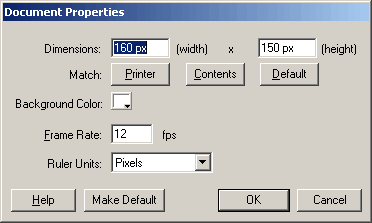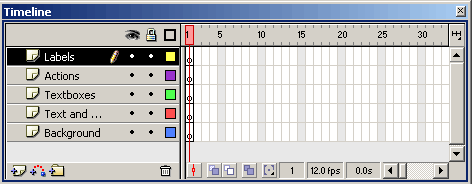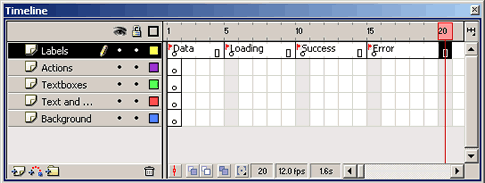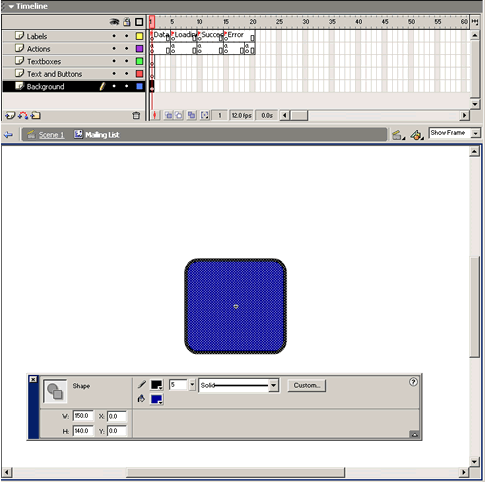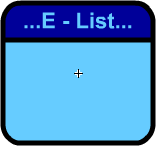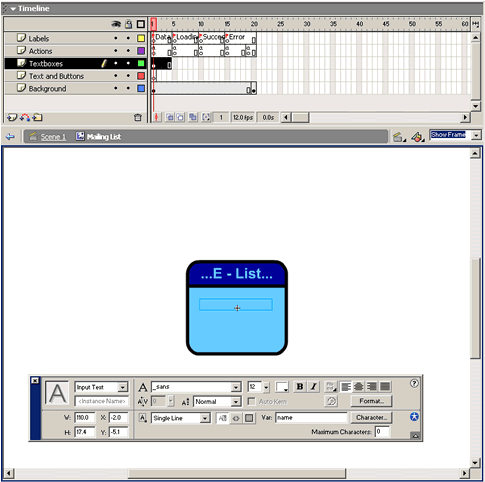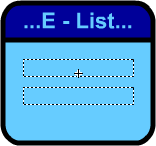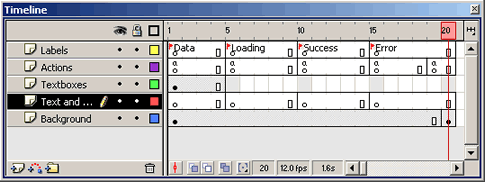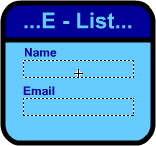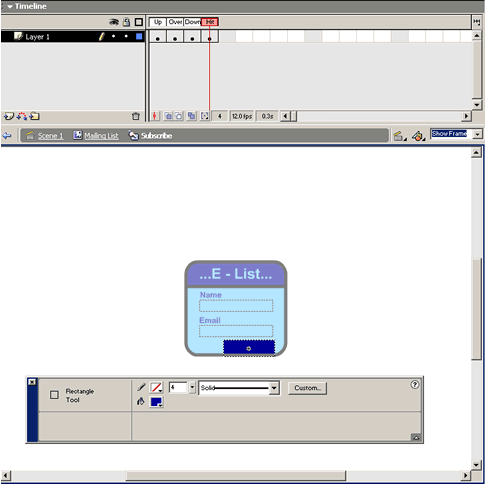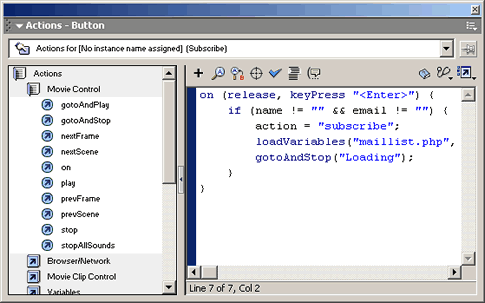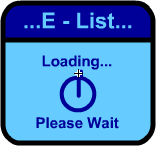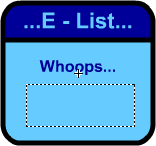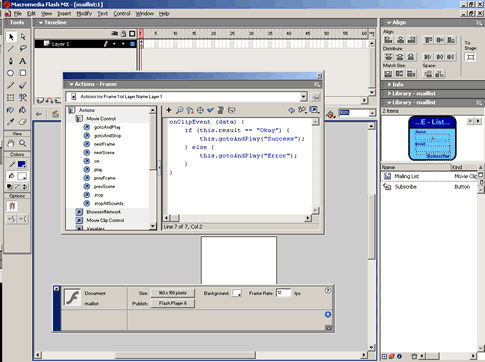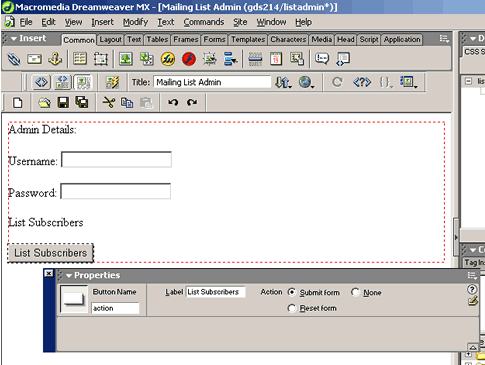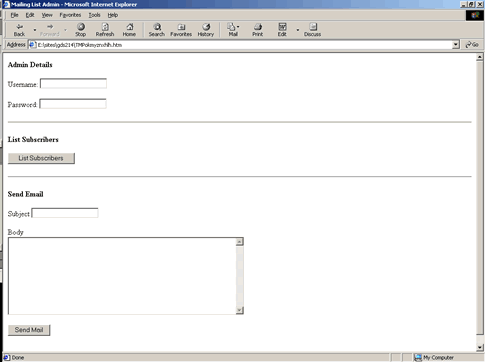|
Parkland
College > Fine & Applied
Arts > Graphic
Design | Web Design
>
GDS 214 WEB DESIGN II
|
|
|
|
Email List Application Flash and PHP Open a new Flash File Make the dimensions 160px and the width 150px
Save your file. I called mine maillist.fla Create a new movie clip. I named mine Mailing List
Add five layers:
Adding the Labels Add keyframes (F7) in the Labels layer at 5, 10, 15, and 20. Name them:
Adding the ActionScript Add blank keyframes at 5, 10, 15, 18 and 20 in the Actions Layer At Frames 5, 10, and 15, add a stop() action in the actions panel In Expert mode, at Frame 15, add: startTime = gettimer() / 1000; At Frame 18, in the expert mode, add: Elapsed = (getTimer() / 1000) - startTime; Adding the Background In the background layer, using the rounded rectangle and the text tool, create a background image for your interface. Add a keyframe at frame 20. I created mine 150px wide by 140px tall. Use the align panel to align it to the center of the stage.
Add a frame (f5) at frame 5 of the text boxes layer Add two input text boxes (be sure input is selected in the property inspector).
Name the var: name for the first box and email for the second.
In the text and buttons layer Add keyframes at 5, 15, and 20 in the text and buttons layer
In the first keyframe, add the static text "name" and "email" to your graphic.
Type in the word "subscribe" below your text boxes and turn it into a button symbol. Insert > Convert to symbol (F9)
Add keyframes to each of the button states. Be sure to add a rectangle to your hit area.
Return to your movie clip Select your button and add the following ActionScript in the ActionScripts panel: on (release, keyPress "<Enter>") {
In the Loading area of the Text and Buttons layer, add the text: Loading... Please wait.
In the success area of the text and buttons layer, add the text: Thank You! Your details have been added to the database.
In the Error Section... Add the static text "Whoops..."
Then add a dynamic field below it. Be sure that Dynamic Text is selected. In the Var field, type errorMsg Select Multiline
Click on Scene 1 to return to the main scene. Drag in a copy of your movie clip and select it. In frame 1 while the movie clip is selected, add the following actionscript in the actions palette: onClipEvent (data) {
|
|
Enter PHP With that done we now need to build up the PHP script to handle the requests from the flash movie. We’I'll use a lot of functions in this code to keep everything easily understandable. Before we kick into the PHP script, we need to think about how we’re going to store the user data in our text files. Since the file function will load each line of the given file into in array element it seems sensible to have one line per subscriber in the file. However, we need to store more than a single piece of data about each subscriber. The information we’ll want to store is: • Name So we need a way of fitting this all on to one line whilst still being able to get at the individual bits when we need to. The answer is to use some kind of separator and then use the explode function to split the string apart when we want to get at the individual bits.
Just so you’re sure about what’s going on here, take a look at a few entries from my text subscriber file: Rob Higgins| rhiggins@shout.net|998254219 Here is how the different data fields are separated. The number at the end is the UNIX time stamp. Here is the code <? //The first thing we do is check that the required data has been sent. if (!isset($email) || !isset($name) || empty($email) || empty($name))
{ //we convert the email address to all lower case //we use a switch statement to check the valuse of the $action
variable //here is the function subscribe options for various errors if (isSubscribed($email)) { $joinDate = time(); //here we open the subscriber dat file //here is the unsubscribe function $subscribers = file('subscriber.dat'); fclose($file); //here is the email function function sendEmail($email, $name) { //here is the email notification function function mailAdmin($email, $name) {
function isBanned($email) { function fail($errorMsg) { function success() { ?>
|
|
|
|
The Administrator Interface. In Dreamweaver... Create a HTML page called listadmin.html Insert a form tag into your document. Add two text fields.
Add a submit button. Name it "Action" and change the text to "List Subscribers"
Add another text field and name it: "mailsubject"
And add a multiline text area named: "mailBody"
Add a submit button and name it "action" Make the Value Send Mail
edit the form action to include the address of your maillist-admin.php page.
Your page should now look like:
The Code should be: <html> <body> |
|
|
|
The Admin PHP Here is the code for the maillist-admin.php file: <? // Decide on what action we need to take function fetchList() { if (!$subscribers) { // For each subscriber line... function sendEmail ($mailSubject, $mailBody) { // Ensure that subject and body of email have // If file open failed... // For each subscriber line... // Build to address including subscriber name ?>
|
|
|
|
The data file The last thing you need to do is create a dat file for your information. go to notepad or another text editor and create an empty file and name it subscriber.dat Upload to your server and change the permissions to 777 chmod 777 subscriber.dat
Upload all files to your server and be sure that the paths are correct in your form and in your other pages. Everything should be cool. Here are the files:
|
|
|
|
|
|
______________________________ Last updated: 8/26/03• Webmaster: Paul Young |
